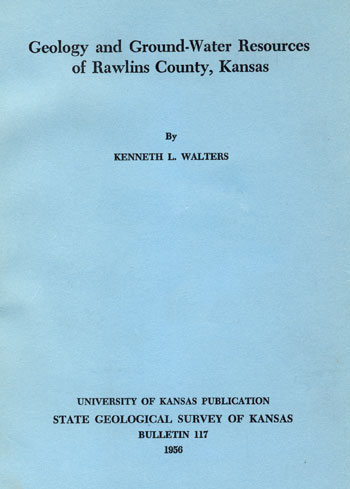Geology and Ground-water Resources of Rawlins County, Kansas
By Kenneth L. Walters

Originally published in 1956 as Kansas Geological Survey Bulletin 117. This is, in general, the original text as published. The information has not been updated.
You may also wish to visit our web site on the Rawlins County geologic map.
Abstract
This report describes the geography, geology, and ground-water resources of Rawlins County in northwestern Kansas. The hydrologic and geologic information was obtained in the field during the summer of 1952. The field data upon which this report is based are given in tables; they include records of 226 wells, chemical analyses of water from 21 representative wells, and logs of 36 test holes and one well.
Rawlins County lies in the High Plains section of the Great Plains physiographic province. It is drained for the most part by Beaver Creek and its tributaries and by Sappa Creeks. The topography in general is an eastward sloping, gently rolling plain, deeply dissected along the valley walls of the principal streams. The climate is subhumid to semiarid, the average annual precipitation being about 18.5 inches. Farming is the principal industry of the county; wheat and cattle are the chief products.
The Pierre shale of late Cretaceous age underlies the entire county, and crops out in a few places along valley walls or floors. The Ogallala formation of Pliocene age overlies the Pierre shale and is one of the principal water-bearing formations of the county. The Meade formation of Kansan age, which overlies the Ogallala formation at a few isolated points, contains a bed of volcanic ash that has been worked on a small scale for commercial use. The Sanborn formation of Illinoian and Wisconsinan age overlies the Ogallala formation or the Meade formation where it is present. The Crete member of the Sanborn formation is composed of sand and gravel in a terrace position and yields moderate to large quantities of water to wells. Alluvium and undifferentiated low terrace deposits of Wisconsinan and Recent age yield quantities of water adequate for irrigation and municipal supplies.
The report contains a map showing the areas of outcrop of the rock formations and the location of test holes and wells for which records are given. The shape and slope of the water table in Rawlins County are shown by means of water-table contours. Geologic cross sections and a map showing the configuration of the bedrock surface are included in this report. Ground water in Rawlins County moves eastward and northeastward; the average slope of the water table is about 14 feet per mile. The depth to water ranges from less than 10 feet in some stream valleys to more than 200 feet in the highest upland areas.
The ground-water reservoir is recharged principally from rain and snow that fall within the county, by percolation from streams and depressions, and by underflow from adjacent areas. Ground water is discharged from the groundwater reservoir by seepage into streams, by transpiration and evaporation, by movement into adjacent areas, and by wells.
A small amount of land is irrigated from wells in Rawlins County. Additional irrigation wells can be developed in most of the major stream valleys. Satisfactory irrigation wells can be developed from the Ogallala formation in western and southern Rawlins County, but construction and operating costs will be higher in relation to the yield than in the valley areas.
The analyses of samples of water from wells in Rawlins County indicate that the water is hard, but suitable for most purposes. In extreme northwestern Rawlins County the water may be locally of poor quality, owing to the influence of the underlying Pierre shale. In general water from t-be Ogallala formation is of better quality than water from the terrace deposits.
Kansas Geological Survey, Geology
Placed on web Nov. 17, 2008; originally published Dec. 1956.
Comments to webadmin@kgs.ku.edu
The URL for this page is http://www.kgs.ku.edu/General/Geology/Rawlins/index.html